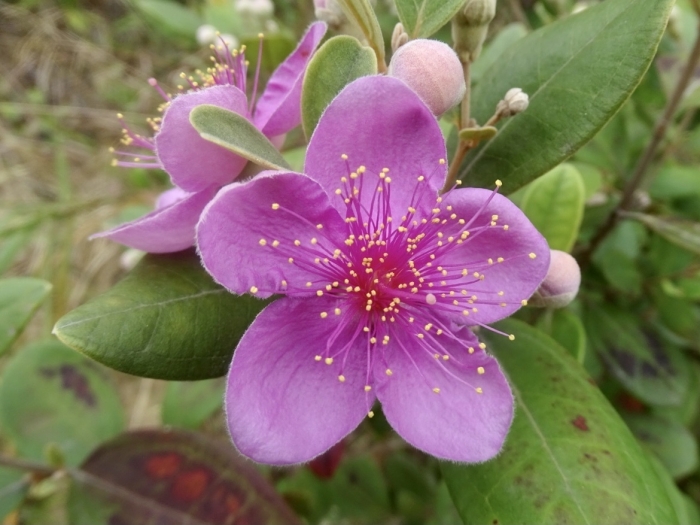Rose Myrtle
(Rhodomyrtus tomentosa)
Rose Myrtle (Rhodomyrtus tomentosa)
/
/

Toby Y
CC BY 4.0
Image By:
Toby Y
Recorded By:
Copyright:
CC BY 4.0
Copyright Notice:
Photo by: Toby Y | License Type: CC BY 4.0 | License URL: http://creativecommons.org/licenses/by/4.0/ | Rights Holder: Toby Y | Publisher: iNaturalist | Date Created: 2021-04-25T00:55:49Z |
































































Estimated Native Range
Summary
Rhodomyrtus tomentosa, commonly known as Rose Myrtle, is an evergreen shrub or small tree native to open woodlands and forest edges in Southeast Asia and parts of the Pacific Islands. It typically grows up to 4 meters (12 feet) tall and wide, with a dense, bushy habit. The leaves are leathery, dark green, and have a hairy underside. Rose Myrtle produces showy flowers that are solitary or in clusters of two or three, each about 2.5–3 cm in diameter, with five petals that are white tinged with purplish-pink or entirely pink. The flowering season extends through the summer months. The edible fruit is a notable feature, being purple, round, and 10–15 mm long, with a sweet flavor that lends itself to culinary uses such as pies, jams, and salads.
Rose Myrtle is valued for its ornamental qualities, including its abundant flowering and attractive fruit. It is commonly used in tropical and subtropical gardens for border planting, as a specimen plant, or for hedges due to its dense growth. It thrives in full sun to part shade and prefers medium to high water levels, with well-draining soil. While it is relatively easy to maintain, gardeners should be aware of its potential to become invasive outside its native range. It has a high seed production and germination rate, with seed dispersal facilitated by frugivorous birds and mammals.CC BY-SA 4.0
Rose Myrtle is valued for its ornamental qualities, including its abundant flowering and attractive fruit. It is commonly used in tropical and subtropical gardens for border planting, as a specimen plant, or for hedges due to its dense growth. It thrives in full sun to part shade and prefers medium to high water levels, with well-draining soil. While it is relatively easy to maintain, gardeners should be aware of its potential to become invasive outside its native range. It has a high seed production and germination rate, with seed dispersal facilitated by frugivorous birds and mammals.CC BY-SA 4.0
Plant Description
- Plant Type: Shrub
- Height: 8-10 feet
- Width: 8-10 feet
- Growth Rate: Moderate
- Flower Color: Pink
- Flowering Season: Summer
- Leaf Retention: Evergreen
Growth Requirements
- Sun: Full Sun, Part Shade
- Water: Medium, High
- Drainage: Medium
Common Uses
Edible*Disclaimer: Easyscape's listed plant edibility is for informational use. Always verify the safety and proper identification of any plant before consumption.
Natural Habitat
Native to open woodlands and forest edges in Southeast Asia and parts of the Pacific Islands
Other Names
Common Names: Hill-Gooseberry, Downy Myrtle, Downy Rose Myrtle, Ceylon Hill-Cherry, Guayabillo Forastero, Kemunting, Ceylon Hill Gooseberry, Isenberg Bush, Feijoa, Hill Gooseberry
Scientific Names: , Rhodomyrtus tomentosa, Myrtus tomentosa, Myrtus canescens, Cynomyrtus tomentosa,
GBIF Accepted Name: Rhodomyrtus tomentosa (Aiton) Hassk.